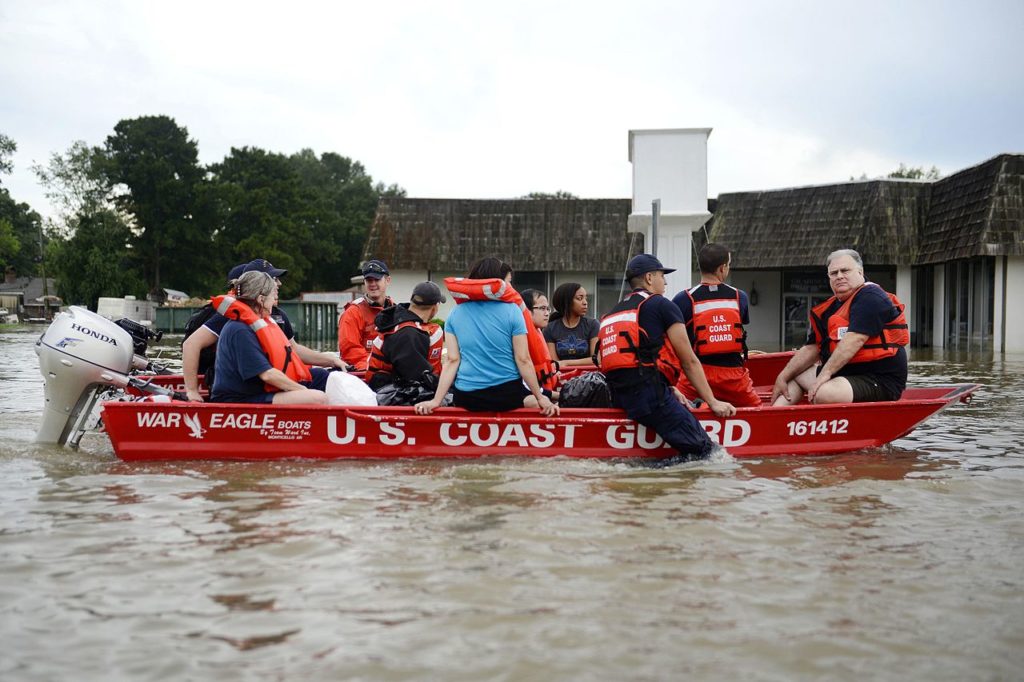New Orleans Floods Again, Sings “The Blues”

August 7, 2017 record rainfall in New Orleans was similar to the record rainfall in nearby Baton Rouge in 2016 depicted above. Photo credit: US Coast Guard – Brandon Giles
Poor New Orleans. Last week it flooded again. This time the cause was not even a hurricane, just 8-10 inches of rain in a few hours. The record rainfall was made much worse with the failure of stormwater pumps. (Washington Post, Heavy Rains Flooded New Orleans As Pumps Faltered.) Misery, hardship, and economic damage are repeating for a city often called “The Big Easy.”
One of the things for which New Orleans (“N’awlins”) is most famous, is music, particularly jazz and “the blues.” The blues tell a story, evoking melancholy and sadness. Often there is repetition of a key story line, the refrain. With the images of disastrous flooding, the blues became a poignant metaphor to me, almost symbolic of the saga of the city. Looking at the “story” upon which these flooding blues are based are a few core elements;
- Centuries-old port city near the mouth of the mighty Mississippi River with amazing and diverse culture
- Flooding from hurricanes often hitting that location in the shallow Gulf of Mexico
- Compacting delta silt, made worse by extracting water and petroleum causing the ground to go down inches per year, effectively raising sea level
- Massive engineering efforts to tame nature and secure the city with levees, rerouting the river, and stormwater pumps
- In recent years, rising water level as a warming planet melts glaciers and ice sheets raising global sea level
- Warmer oceans increasing evaporation and causing record rainfall now repeatedly breaking records
- Grave reluctance to abandon the city or even to disturb the historic architecture by elevating buildings and streets
- Increasingly frequent flooding disasters causing loss of life
It might be tempting to think that higher levees and more pumps will save New Orleans and the region. The triple threat of sinking land, rising seas, and ever-increasing record rainfall suggests a new reality however. Sooner or later––and likely sooner––areas at the mouth of the Mississippi need to be elevated, or relocated. Otherwise they will be inundated.
How we describe or frame such things affects how we perceive them. The rainfall last week was deemed to be a “one in a thousand year event.” Such terms as “hundred year floods” were meant to convey statistical probability. A thousand year event being one chance in a thousand, or one tenth of one percent. A one hundred year flood is defined as a one percent chance of such an event in a given year. Extraordinary rainfall due to the higher evaporation rates with a warming ocean are changing the baseline. Old statistics are no longer valid, yet often give some comfort about the rarity or unlikely aspect of a recurrence. They are now archaic and should be abandoned. We are repeatedly having “thousand year events.”
Last week it was New Orleans. Exactly one year ago, in Baton Rouge, just fifty miles from New Orleans, there was another thousand year rain event, dumping more than 20 inches in a single day, as shown in the photo above. And just a decade ago, Hurricane Katrina caused massive damage to the New Orleans – Baton Rouges area, triggering nearly $300 Billion dollars of adaptation and restoration by the Federal government. Still we had yet another flood disaster just a week ago. Rising seas, sinking land, the limitations of levees and pumps need to be recognized. Though emotionally difficult to break from the past, the sooner we see the larger story, the better.
To be clear the problem is not limited to this region. A few weeks ago I wrote about floods from Arizona to Cornwall. A year ago, record rainfall and flash floods stretched from Ellicott City, Maryland to China. We are in a new era. It is time to think bigger with our adaptation plans. We need to look realistically at elevating buildings, streets, and infrastructure, or moving inland to higher ground. Until we accept this new reality, we will likely keep singing the “blues”.
